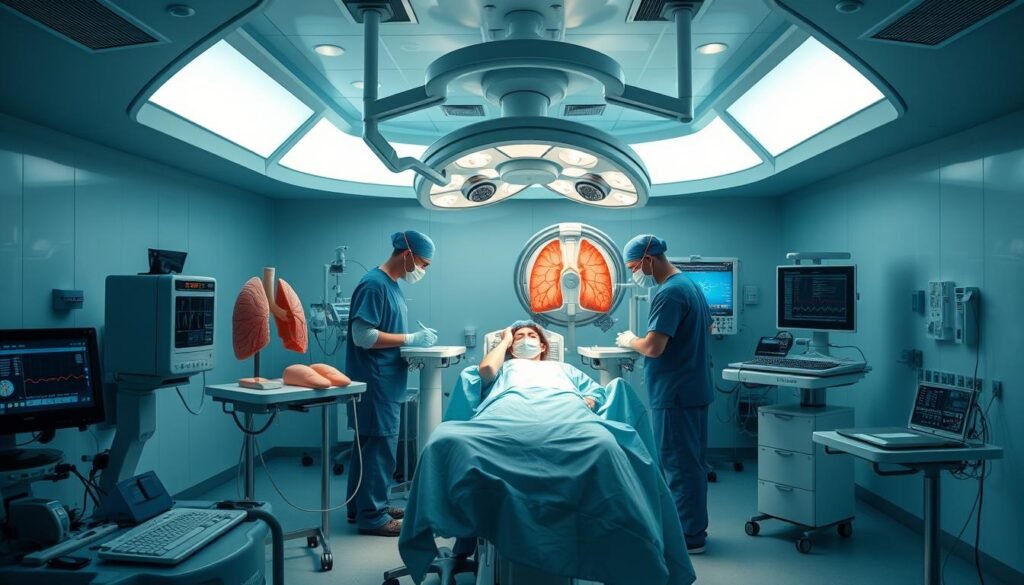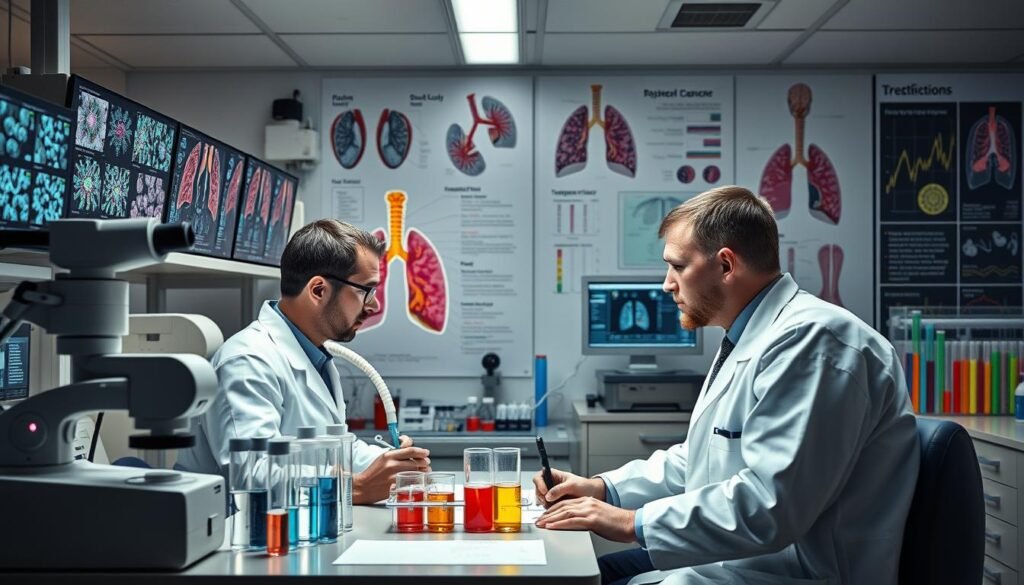Small cell lung cancer (SCLC) makes up about 15% of all lung cancers. It’s a very aggressive cancer that’s hard to treat. Often, it’s not found until it’s quite advanced. But for around 30% of patients, the cancer hasn’t spread too much when it’s found. This means surgery could be an option for them. We’re going to look into how surgery can help with SCLC, the treatment methods, and how surgery fits with other treatments.
Key Takeaways
- SCLC accounts for roughly 15% of lung cancer cases, primarily featuring small cell carcinoma.
- Only 30% of cases are diagnosed at a limited stage, where surgery might be feasible.
- The 5-year survival rate for SCLC is about 5% to 10%, emphasizing the disease’s severity.
- Surgery is considered when the cancer is confined to the lung without metastasis.
- Long-term disease-free survival is rare, underscoring the importance of follow-up treatments in oncology care.
- Combined therapies, including chemotherapy and radiation, play a pivotal role alongside surgical interventions.
- Prophylactic cranial radiation can enhance survival in patients responding well to initial treatments.
Understanding Small Cell Lung Cancer
Small cell lung cancer (SCLC) grows fast and starts in the lung tissues. About 13% of all lung cancer cases are SCLC. This is less common than non-small cell lung cancer. SCLC is aggressive and spreads quickly to other parts of the body such as bones, liver, and brain.
What is Small Cell Lung Cancer?
SCLC is known for rapid growth and quick spread. It is hard to detect early because it spreads fast. SCLC has two main stages: limited and extensive. In limited stage, cancer is in one lung and maybe nearby lymph nodes. In extensive stage, it has reached the other lung, distant organs, or fluid around the lung. Treatment usually involves chemotherapy and often radiation therapy too.
Types of Small Cell Lung Cancer
There are two key types of SCLC:
- Small cell carcinoma (oat cell cancer) – Known for quick growth and spreading.
- Combined small cell carcinoma – Has small and non-small cell parts, making treatment harder.
Surgery is rare in SCLC, used in under 5% of cases where cancer is just one lung tumor. Surgery isn’t usually the first choice because the disease often spreads before being found. In early stages, though, surgery options like pneumonectomy, lobectomy, segmentectomy, and sleeve resection might be looked at. Dealing with SCLC requires focusing on each patient’s unique needs.
Risk Factors for Small Cell Lung Cancer
Knowing what increases the chance of lung cancer is key. For Small Cell Lung Cancer (SCLC), a few critical factors are at play. They make the disease more likely to occur.
Primary Risk Factors
Smoking is the top cause of lung cancer, leading to about 85% of cases. This includes smoking cigarettes, cigars, and pipes. Each adds to the risk of SCLC. Even secondhand smoke poses a big risk for those not smoking.
People with a personal or family history of lung cancer are also at higher risk. Smoking while taking beta-carotene supplements could increase this risk more. Radon exposure is the second main cause, especially for non-smokers. It shows that not all risks come from personal choices.
Environmental Influences
Workplace exposure to things like asbestos can raise the risk, smoking makes it worse. Those who had radiation therapy for other cancers are more likely to get lung cancer too.
Air pollution plays a smaller role but is still a concern in the U.S. The effects of marijuana and e-cigarettes are still being studied. Right now, we don’t have clear answers on their risks.
Understanding these risk factors helps people make better health choices. For expert advice, talking to a top lung cancer oncologist is useful. They offer insights and advanced treatment options. More info is available at top lung cancer oncologists.
Symptoms of Small Cell Lung Cancer
It’s vital to know the symptoms of lung cancer early. Small cell lung cancer (SCLC) starts with signs that look like usual breathing problems. These include a constant cough and dyspnea, which suggest something more serious is at play.
Common Symptoms
People may first notice:
- Persistent cough that lingers
- Shortness of breath or dyspnea
- Chest discomfort or pain
These symptoms can get worse quickly, needing a doctor’s check. Losing weight without trying is another key symptom. It can happen as the cancer grows without any changes in diet or exercise.
Advanced Symptoms
As the cancer spreads, symptoms become severe:
- Cough may become worse and include blood
- Intense chest pain
- Pronounced dyspnea, even when resting
- More weight loss with no clear reason
These symptoms of lung cancer could mean the cancer is spreading, requiring quick action. If you see these signs, get checked soon to learn about treatment choices. For more on small cell lung cancer, see this link.
Diagnosis and Staging of Small Cell Lung Cancer
Getting the right diagnosis and staging for lung cancer is key. It helps pick the best treatment for small cell lung cancer (SCLC) patients. Doctors use many tests to find out the cancer’s stage, which decides the treatment path.
Diagnostic Procedures
Doctors start by using imaging tests for small cell lung cancer, like:
- Chest X-rays
- Multidetector CT (Computerized Tomography) scans
- MRI (Magnetic Resonance Imaging)
- Nuclear imaging, such as PET scans or bone scans
Then, a biopsy is often needed to confirm cancer. There are different ways to do a biopsy, such as:
- Fine and core needle biopsies
- Bronchoscopy
- Endobronchial ultrasound (EBUS)
- Navigational bronchoscopy
- Surgical procedures like mediastinoscopy
A team of specialists works together to choose the best tests for each case.
Staging Impact on Treatment
The stage of cancer plays a big part in choosing treatment. The TNM system helps doctors understand:
- The size and extent of the main tumor (T)
- Spread to nearby lymph nodes (N)
- Metastasis to other organs (M)
SCLC is mainly categorized into two stages:
- Limited-stage: Cancer is in one lung and nearby areas. It might be treated with one radiation area.
- Extensive-stage: Cancer has spread more widely, even to the bone marrow.
About one-third of SCLC cases are limited-stage when diagnosed. Meanwhile, two-thirds are extensive-stage. Knowing how far the cancer has spread shapes the treatment plan. Doctors including surgical, medical, and radiation oncologists often work together on this.
Treatment Options for Small Cell Lung Cancer
Treatment strategies for small cell lung cancer aim to enhance outcomes. It’s important to understand the available options for effective treatment. Factors like cancer stage, location, and patient health help choose the right methods.
Overview of Treatment Modalities
The treatment for small cell lung cancer includes several approaches:
- Chemotherapy
- Radiation therapy
- Surgery
- Chemoradiotherapy
- Prophylactic cranial irradiation
- Chemotherapy combined with immunotherapy
Chemotherapy is key, particularly for early-stage disease. It’s often combined with radiation to improve results. Surgery is less common. For advanced disease, treatments focus on systemic approaches.
Role of Chemotherapy and Radiation Therapy
Chemotherapy uses drugs like etoposide plus cisplatin or carboplatin. These drugs work well, with a success rate of about 70%. For those with early disease, chemoradiotherapy is standard. This method attacks the cancer fully. Radiation therapy helps by focusing on the primary cancer and preventing spread to the brain.
A team approach boosts treatment success. This team includes respiratory doctors, oncologists, and other support staff. Clinical trials are also an option, offering access to new therapies. These aim to better current treatments and lessen side effects.
Surgery For Small Cell Lung Cancer
Surgery is important in early-stage small cell lung cancer. It helps when the cancer hasn’t spread to lymph nodes. This approach may offer better survival chances than other treatments.
When Surgery is Considered
About one-third of people with this cancer might get surgery in early stages. Doctors need to check if a patient qualifies for surgery. Only 2.4% of patients have surgery, based on their health and cancer stage.
Types of Surgical Procedures
There are different surgeries for small cell lung cancer, based on the patient’s needs. Common ones include:
- Lobectomy: This involves removing a lung lobe and is the most common.
- Pneumonectomy: This is when an entire lung is removed, for widespread cancer.
- Segmentectomy: It’s used for smaller tumors, removing a lung segment.
- Sleeve resection: This removes part of the bronchus and lung segment.
The surgery method can be open or less invasive, like VATS or robotic-assisted surgery. Robotic surgery means less bleeding and quicker recovery.

Surgery, especially resection, can greatly impact survival. Discussion with doctors is key to weigh the benefits and risks. For more on surgeries, visit this link.
Pre-operative Testing and Assessment
Before surgery for small cell lung cancer, doctors must fully check if a patient is healthy enough for it. They use special tests to make sure the patient’s body can handle the surgery.
Pulmonary Function Tests
Pulmonary function tests (PFTs) are key to checking lung health. They include tests like spirometry. These tests help find any breathing problems that could make surgery risky.
In a study with 872 patients, many showed lower DLco levels. This means they could have complications during or after surgery. Also, low VO2 max levels increase the risk of problems after surgery. If VO2 max is too low, the risks get higher.
Heart Function Evaluation
Checking heart health is just as important before surgery. It shows if the heart can handle the stress of surgery. Tests like echocardiograms and EKGs are used.
People with VO2 max under 20 ml/kg/min are at higher risk after major surgeries. Simple exercises like the shuttle walk test help doctors decide if surgery is safe. Failing these tests means a higher risk of problems and death. So, a full heart check is crucial for patient safety.
Post-operative Care and Recovery
Post-operative care is crucial after lung cancer surgery. It helps manage complications and boosts the patient’s overall health. During their recovery, which can last weeks to months, patients might face several challenges. Knowing what to expect can make recovery smoother.
Common Side Effects and Complications
After surgery, patients often deal with side effects and complications. Experiencing soreness or pain in the first week is common. To handle this, pain management is key. Around 30% of patients may be in a high dependency unit post-surgery for close watch. Infection and breathing issues might also occur, especially due to tubes placed in the lungs. These tubes help with breathing and managing fluids.
| Side Effects/Complications | Description | Management Strategies |
|---|---|---|
| Soreness/Pain | Common during the first week post-surgery. | Pain management through medication. |
| Infection Risk | Potential due to surgical incisions. | Monitoring and antibiotic therapy if required. |
| Breathing Difficulties | Caused by tube placements. | Respiratory therapy and guidance on breathing exercises. |
| Drain Tube Presence | Common for fluid management. | Regular checks and timely removal. |
Long-term Care Needs
Long-term care is key for a good recovery after lung surgery. Pulmonary rehab programs are important to better lung function and health. It’s also crucial to see your doctor regularly, from 2 to 6 weeks after surgery, for check-ups and to discuss any further treatments. Making lifestyle changes, like stopping smoking and exercising, is vital for long-term well-being.
Often, stitches are taken out about 10 days after you leave the hospital. This is part of a care plan made just for you. Ongoing support from healthcare providers ensures patients get the best care specific to their needs. This kind of care can greatly help with recovery.

Adjuvant Therapies Following Surgery
After removing small cell lung cancer (SCLC), adjuvant therapies become key. They help improve survival by targeting leftover cancer cells. Chemotherapy and radiation therapy are common choices. These treatments are crucial for effective SCLC management.
The Importance of Follow-up Treatments
Post-surgery, follow-up treatments are vital for SCLC patients. Studies of 1,574 patients showed many benefited from these therapies. Specifically, 354 received chemotherapy and 190 got chemo plus radiation. This led to a median overall survival of 24 months. A noticeable boost in 5-year survival rates was also seen. These findings underline the importance of post-op care.
Integrating Chemotherapy and Radiation
Combining chemotherapy and radiation improves SCLC patient outcomes. This approach has raised the median survival rate. It also increased the 5-year survival rate by 12.3%. Prophylactic cranial irradiation (PCI) helps manage tiny cancer spread. Though thoracic radiotherapy alone didn’t show major benefits, pairing chemotherapy with PCI is vital. Tailored care and close monitoring make these combinations more effective.
| Type of Treatment | Patients Involved | Median Overall Survival | 5-year Survival Rate |
|---|---|---|---|
| Adjuvant Chemotherapy | 354 | 66 months | 52.7% |
| Chemo-Radiation | 190 | 66 months | 52.7% |
| Radiation Therapy Alone | 22 | No significant improvement | Comparable to surgery only |
After surgery, adjuvant therapies remain crucial. Ongoing research and trials aim to improve these treatments. For more on adjuvant therapies and patient outcomes, check out these studies.
Research and Clinical Trials
Ongoing lung cancer research is vital for better treatment options and new therapies. Clinical trials are key in finding new methods to fight small cell lung cancer (SCLC). These studies test new treatments for safety and effectiveness. This leads to significant treatment advancements in lung cancer care.
Current Developments in Treatment
There are several new treatments being tested:
- A study is looking at the effectiveness of BI 1015550 over 52 weeks in patients with Progressive Fibrosing Interstitial Lung Diseases (PF-ILDs).
- A Study of ADXS-503, with or without Pembro, is trying to find the safest dose. It also checks how well it works against lung cancer that has spread.
- Research on Ociperlimab with Tislelizumab versus Pembrolizumab focuses on certain lung cancers. It looks at how tumors respond.
- A trial compares Relatlimab plus Nivolumab to Nivolumab alone. It’s for first-time treatment of severe NSCLC. The goal is to see if it helps patients live longer without their disease getting worse.
Importance of Clinical Trials
Clinical trials offer patients new treatment options that aren’t widely available. However, less than 5% of adult cancer patients join these important studies. Each trial adds to our understanding of lung cancer. This helps improve treatment methods and results in better care for patients.
Including patients in clinical trials helps their health and advances lung cancer research. This is crucial for finding more effective treatments.

Conclusion
The journey through small cell lung cancer (SCLC) treatment is not simple. It needs a team of doctors. Surgery is mostly for those found with the disease early on. It’s crucial to know about all the treatment methods available.
It’s important to talk about surgery options with your doctor. This is because there’s a small risk of dying from surgery. But, there’s a good chance of living disease-free for three years if additional treatments are used.
Treatments like chemotherapy and radiation are promising for early-stage patients. They can greatly increase the chances of survival. Adding immunotherapy has also shown to make outcomes better. You can read more about combining surgery with other treatments here.
Getting to know all about SCLC treatment is critical. Talking with doctors and looking into clinical trials helps. There’s hope for better survival and life quality with ongoing research and new treatments.